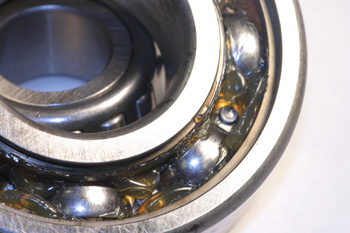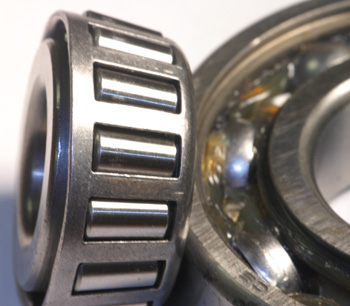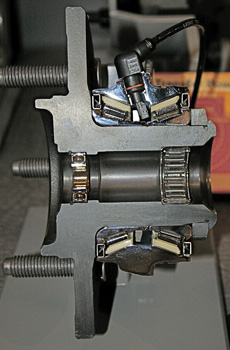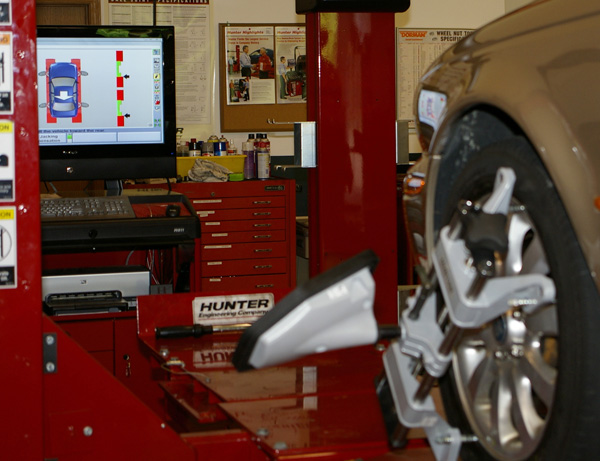 How much load can a wheel bearing carry?
How much load can a wheel bearing carry?
On a typical passenger vehicle weighing around 3,400 pounds, each pair of front-wheel bearings, as well as the rear-wheel or axle bearings, support around 850 pounds, depending on the weight balance and driveline configuration. If it’s a 6,000-pound SUV, each bearing might carry about 1,500 pounds. This load is concentrated on the relatively small bearing surfaces. These loads do not even take into account the dynamic loads produced by cornering.
These loads that are put on the bearing are called thrust and radial loads. These are the forces the bearing must endure when the vehicle is cornering or braking. Another force that can not be measured is the force of impacts from potholes and curbs.
Besides reducing friction, what else does wheel bearing grease/lube do?
Lubricants aid in carrying away heat, protecting bearing surfaces from corrosion and reducing friction.
How long can a wheel bearing last?
Most serviceable wheel bearings need maintenance every 25,000 to 30,000 miles, or during every brake service. But, the average life of a sealed wheel bearing and hub assembly is about 85,000 to 100,000 miles, without the opportunity for you to repack the bearings. You may only have one chance during a vehicle’s life to replace these parts. If you miss this opportunity, it may be gone forever.
When are bearings replaced?
According to a recent Babcox Research survey, 51 percent of bad wheel bearings are identified and replaced as a result of a customer complaining about noise, 24 percent are found during a brake job, and 19 percent are discovered during an alignment.
What is the leading cause of wheel bearing failure?
The leading cause of a wheel bearing failing is its seal. The inside of a bearing can be a hot place. When a bearing is cooling off, the contracting metal, air and lubricant can create a vacuum that is hopefully held by the seals. If the seals are worn and can’t hold the vacuum, the bearing or sealed hub unit will suck in outside air, debris and water. In some parts of the country that use salt on the roads, it is almost as bad as ocean water on wheel bearings.
As these contaminants circulate through the grease and between the races and bearings, the components wear. Once a bearing is worn, the wear rate is accelerated by seals that no longer keep out contaminants, and increased heat may breakdown and eventually expel the lubricants. This is a slippery slope that could quickly lead to catastrophic failure.
Can too much grease cause a wheel bearing to fail?
Over filling a bearing with too much grease can cause excess churning of the grease during operation and high temperatures, resulting in overheating and excess grease purging (leaking). Overheating occurs because the heat generated cannot dissipate correctly, continually building until damage occurs. When a bearing overheats and pushes out the grease, the sealing lip can be damaged and “blown out” in the reverse direction.
 Do I need to uncover why the previous bearing failed?
Do I need to uncover why the previous bearing failed?
Yes. When a bearing wears out, it is usually a case of inadequate lubrication, faulty installation or improper adjustment. For the repair to be successful, you must first determine why the previous bearing failed. For sealed hub units, examining the internal bearings and races is impossible.
Interview the customer to find out what kind of roads they drive on. Also, ask what types of loads they carry. If the customer overloads the vehicle, bearing damage could be inevitable. The most common failure pattern for bearings is for those on the passenger side of the vehicle to fail first. The passenger side bearings are exposed to the most standing water in the gutter. If the bearings on the driver side of the vehicle fail first, take an extremely close look at the passenger side bearings, failure may not be far behind.
The lubricant and bearing surfaces have a dark appearance and coating, what happened?
Burned or oxidized lubricant may leave a dark coating on bearing surfaces. If a bearing overheats, the hot lubricant breaks down and can cause scoring and even etching of the bearing surfaces. Also, water and other corrosive elements can create this condition, which leads to spalling down the road. Remember that with tapered roller bearings, excessive pre-load can mimic this same damage. If a bearing gets really hot, cages and seals could be deformed and lead to bearing lockup.
Can wheel bearing grease wear out?
Grease is a precise combination of oil, thickener and additives. Grease acts like a sponge to retain and release the oil. As a result of time and temperature conditions, the oil release properties can become depleted. When this occurs, the grease is worn-out.
 A cheaper hub unit has the same appearance as a high-quality, brand-name unit. What is the difference?
A cheaper hub unit has the same appearance as a high-quality, brand-name unit. What is the difference?
Bearings are precision products that require complex manufacturing processes. Inferior bearings that use low-quality steel and have poor heat-treating can wear and spall prematurely. The poor quality steel may have inclusions of hard or soft metal that can cause a premature failure. In summary, an inexpensive bearing may look the same as a high-quality bearing, but it is what you can’t see that makes a difference between a comeback and a satisfied customer.
Also, some cheaper hub units are using smaller bearing sizes than the OEM intended. This can lead to premature failure. Unfortunately, the only way to tell is to destroy the new bearing.
What is the the most important tool a technician should have in their box if they are going to install wheel bearings?
On serviceable bearings, the most important service tip is to invest in a good set of seal drivers. Even a slight distortion in a seal made during installation can shorten the life of the bearing inside.
Why can’t I use an impact wrench to secure the axle nut?
While it may appear to be easier to use an impact wrench, it is not recommended. OEM and bearing manufacturers always recommend using a torque wrench for installation. During removal, an impact wrench can damage the axle nut threads and shock the CV joints. It can also create a false sense of security when adjusting a nut or bolt, which may be under or over torqued. This can leave a hub assembly susceptible to failure. Also, in almost all cases, use a new axle nut. Some axle nuts are designed to be used only once, and can not be adjusted.
What is the right way to adjust a tapered roller bearing?
Always check the service information for the correct procedure. Overtightening adjustable tapered roller bearings is a common error that can lead to premature failure. Tapered roller bearings on the front of RWD vehicles are never preloaded. They’re snugged up with no more than 15 to 20 ft. lbs. of torque while rotating the wheel to make sure the bearings are seated. Then the adjustment nut is loosened 1/6 to 1/4 turn, and locked in place with a new cotter pin. As a rule, endplay should be about 0.001 to 0.005 inches.
 I can not get a consistent toe reading on a car I am aligning. The tie rods and steering gear are tight. What could be the problem?
I can not get a consistent toe reading on a car I am aligning. The tie rods and steering gear are tight. What could be the problem?
A problem that may occur with older, serviceable wheel bearings is incorrect adjustment. Too much play can allow steering wander (which may be mistaken for worn steering components or the need for an alignment). One way to check wheel-bearing play is to raise the wheels off the ground and rock the tires in and out while watching for any looseness. As a rule, there should be no play on most FWD cars, but up to .010 inch of play in the front bearings may be acceptable on RWD cars and trucks with adjustable bearings.
There should be no play on most FWD cars, but up to 0.010 inch of play in the front bearings may be acceptable on RWD cars and trucks with adjustable bearings. On FWD cars with adjustable tapered roller rear wheel bearings, the bearing adjustment procedure is usually the same as with RWD vehicles (zero pre-load), but some do require a slight pre-load.
How do I know when to replace and repack wheel bearing grease?
Colored and UV dyes can be added to a grease as assembly aids or to facilitate inspections. The original color of a grease has little to do with its performance.
Automotive wheel bearing grease contains corrosion inhibitors and anti-wear and water-resistant additives, offering superior protection in challenging environments.
A softened sealing lip surface is the sign of a compatibility problem with the grease and seal. The wrong grease can cause a rubber seal to swell and disintegrate.
The fresh grease is smooth and buttery compared to the water-laden grease, which is milky white in appearance. As little as one percent water in grease can have a significant impact on bearing life.






